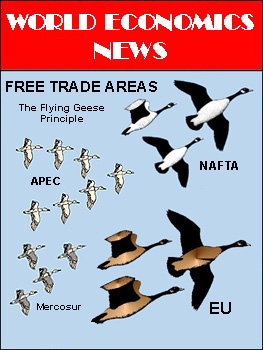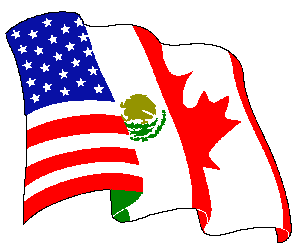 February
27, 2000 International participation in Free Trade Areas (FTAs)
grew
rapidly in the second half of the 20th century, and plans are underway
to expand regional economic integration in the century ahead. The
reason is simple. FTAs are engines of growth and progress.
They exploit country comparative advantages, accommodate specialization
and division of labor, expand the size of export markets, and promote
efficiency
and competition within the free trade area.
February
27, 2000 International participation in Free Trade Areas (FTAs)
grew
rapidly in the second half of the 20th century, and plans are underway
to expand regional economic integration in the century ahead. The
reason is simple. FTAs are engines of growth and progress.
They exploit country comparative advantages, accommodate specialization
and division of labor, expand the size of export markets, and promote
efficiency
and competition within the free trade area.
Free Trade Areas are like flying geese that work together as a team
to reach a desirable distant destination. Individually, a single
goose does not have the strength and endurance to make the
journey.
However, flying in a V or chevron formation and working as a team makes
it possible for the group to accomplish what they could not do
alone.
Flocks of geese can migrate thousands of miles, and the bigger the
flock
the further they can travel.
The largest and most successful "flock of nations" is the European
Union
(EU). It began with six countries (Belgium, France, Germany,
Italy,
Luxembourg, and the Netherlands) that signed the Treaties of Rome in
1957,
forming the European Economic Community (EEC). The original
objectives
were to realize a political association that brought West Germany into
the Western European Alliance and to develop a plan for the post war
reconstruction
of the region. Over subsequent years it evolved to the present
day
15 member European Union (EU), eleven of which are members of the
European
Monetary Union (EMU). The EU represents 6.3% of the world's
population,
20% of world GDP, and over 40% of world exports.
The eleven member European Monetary Union (EMU) represents the
highest
degree of economic integration among nations. There are other
less
ambitious degrees of international cooperation. The most basic is
a Free Trade Area which is an agreement between two (or
more)
countries to reduce or eliminate trade barriers among members, but each
member nation maintains its own external trade policy for non member
countries.
The North American Free Trade Agreement (NAFTA) combining the United
States,
Canada, and Mexico is an example. The next level of integration
is
a Customs Union which is like a free trade area,
but
the member countries have a common external trade policy for non
members.
The European Economic Community (EEC) was originally a customs
union.
However, by the 1990s it had evolved to a full-fledged Common
Market
which, in addition to having a common external trade policy, allows for
free mobility of labor and capital within its region. The final
stage
of economic integration is a Monetary Union where the
countries
have a common currency and centralized monetary policy. The
United
States of America (USA) is a monetary union with the dollar as its
currency
and the Federal Reserves system as its central bank. It is also a
Political Union with a common set of laws and tax
policies
governing the 50 states.
 Free
Trade Areas tend to involve countries within a geographic region, but
the
United States entered into its first free trade agreement with
Israel
in 1985. Later, it signed an agreement with Canada in 1989, and
more
recently Mexico was added in 1994 to form the North American Free Trade
Agreement (NAFTA). The three member NAFTA represents just over 5%
of the world's population, approximately 23% of world GDP, and about
18%
of the world's exports. Each of the three member countries
derives
significant benefit from their agreement to reduce trade
barriers.
The United States needs resources from both Canada and Mexico, and it
needs
a large market for its export sector. Canada is a large
industrialized
country, rich in both resources and literacy, but with a small
population
and domestic market. Mexico has an abundance of oil and natural
gas.
It also has a rapidly expanding population and a relatively large
semi-skilled
and unskilled labor force. It needs the US and Canadian
markets
to help expand its exports and create more jobs in Mexico.
Free
Trade Areas tend to involve countries within a geographic region, but
the
United States entered into its first free trade agreement with
Israel
in 1985. Later, it signed an agreement with Canada in 1989, and
more
recently Mexico was added in 1994 to form the North American Free Trade
Agreement (NAFTA). The three member NAFTA represents just over 5%
of the world's population, approximately 23% of world GDP, and about
18%
of the world's exports. Each of the three member countries
derives
significant benefit from their agreement to reduce trade
barriers.
The United States needs resources from both Canada and Mexico, and it
needs
a large market for its export sector. Canada is a large
industrialized
country, rich in both resources and literacy, but with a small
population
and domestic market. Mexico has an abundance of oil and natural
gas.
It also has a rapidly expanding population and a relatively large
semi-skilled
and unskilled labor force. It needs the US and Canadian
markets
to help expand its exports and create more jobs in Mexico.
NAFTA is still a work in progress. It ultimately plans to
eliminate
tariffs among the three countries on industrial products by the year
2004.
Its rules of origin requires that a product contain 62.5%
domestic
content (i.e., within the region) in order to qualify for tariff free
movement.
That way other nations cannot locate final assembly plants or
distribution
centers in Mexico and then ship them to the large US market duty free.
NAFTA demonstrates that free trade agreements have their
detractors.
One of the fears is that jobs will be lost in the home country to (more
efficient) producers in the other member countries. This was an
especially
large issue in the United States when Mexico joined NAFTA. Many
people
were opposed to Mexico's entry out of concern that American jobs would
be lost to Mexican workers who work for lower wages. There was
also
a concern that Mexico's lower environmental standards gave Mexican
firms
an unfair comparative advantage. There is an element of validity
to both of these concerns. When a free trade agreement is
initially
launched, there are shifts in resource utilization and trade
patterns.
Each region begins to specialize in its comparative cost
advantage.
Mexico has a distinct cost advantage in products that are produced with
relatively low and semi-skilled labor. On the other hand,
importing
duty free components from Mexican companies into the United States
benefits
many producers in the United States and their customers.
Consumers
are the biggest beneficiaries of a free trade agreement, because they
get
better products for lower prices. Ironically, most consumers are
not conscious of this. Recent opinion polls taken in the United
States
indicate that most Americans have a negative opinion of NAFTA.
Respondents
also indicate that they do not want the United States to enter into any
more free trade agreements in the future.
Although most Americans have a negative opinion of free trade
agreements,
negotiations are underway to form the most ambitious free trade area of
them all. The Asia-Pacific Economic Cooperation (APEC) currently
involves 21 countries spanning 4 continents. It includes large
countries
like the United States, Japan, Canada, Russia, Australia and the
People's
Republic of China as well as small countries like Chile, Peru,
Indonesia,
Thailand, Brunei Darussalam, Philippines, and Vietnam.
Originally,
the Osaka Action Agenda in 1995 set a goal to form a free trade area
among
the developed country members by the year 2010, and the developing
countries
were to be enjoined in 2020. More recently, the focus has shifted
to bring about free trade more rapidly among all members in nine
product
sectors including energy, chemicals, medical equipment, fish, and
forest
products. APEC's 21 countries currently account for over 40% of
world
trade.
Many of the members of APEC already belong to the 10 country
Association
of Southeast Asian Nations (ASEAN) which was originally formed by 5
Southeast
Asian nations in 1984 and added 4 more nations in the 1990s.
ASEAN
is comprised of small, developing nations with a combined GDP of less
than
US $600 billion, but earlier this month representatives met in Jakarta,
Indonesia to consider the feasibility of an Asian Free Trade Area
(AFTA)
alliance with Australia and New Zealand's Closer Economic Relations
(CER).
The preliminary date for inauguration of AFTA-CER is 2010.
 An
AFTA-CER alliance would not be the first time that two distinct
geographic
free trade areas considered merging. A merger between the
European
Union (EU) and the Southern Cone Free Trade Area (MERCOSUR) in South
America
is already scheduled for full completion in the year 2005.
MERCOSUR
was formed in 1991 and is comprised of 6 countries: Argentina,
Brazil,
Paraguay, and Uruguay are the original members; Bolivia and Chile
joined
as associate members in 1996. Following its inception, relations
between Brazil and Argentina improved and trade within the region
increased
dramatically. However, it underscores another problem with free
trade
areas called the
trade diversion effect. When a country enters
into a free trade agreement with its associate members, it diverts
trade
from outside the region to more trade within its own area because of
the
tariff reduction or elimination. Maintaining relatively high
tariffs
for non members gives members an advantage, but it precludes imports
from
non member countries that may otherwise have a comparative
advantage.
Consumers benefit from more trade within the region, but they must pay
higher prices for products produced outside the region. In other
words, there is a positive
trade creation effect but also a negative
trade
diversion effect. The broader the free trade area, the
smaller
the trade diversion effect. For this reason, some experts think
that
MERCOSUR is the natural and logical foundation for a larger South
American
Free Trade Area (SAFTA) to be formed sometime in the not too distant
future,
and it was the impetus for its merger with the European Union (EU).
An
AFTA-CER alliance would not be the first time that two distinct
geographic
free trade areas considered merging. A merger between the
European
Union (EU) and the Southern Cone Free Trade Area (MERCOSUR) in South
America
is already scheduled for full completion in the year 2005.
MERCOSUR
was formed in 1991 and is comprised of 6 countries: Argentina,
Brazil,
Paraguay, and Uruguay are the original members; Bolivia and Chile
joined
as associate members in 1996. Following its inception, relations
between Brazil and Argentina improved and trade within the region
increased
dramatically. However, it underscores another problem with free
trade
areas called the
trade diversion effect. When a country enters
into a free trade agreement with its associate members, it diverts
trade
from outside the region to more trade within its own area because of
the
tariff reduction or elimination. Maintaining relatively high
tariffs
for non members gives members an advantage, but it precludes imports
from
non member countries that may otherwise have a comparative
advantage.
Consumers benefit from more trade within the region, but they must pay
higher prices for products produced outside the region. In other
words, there is a positive
trade creation effect but also a negative
trade
diversion effect. The broader the free trade area, the
smaller
the trade diversion effect. For this reason, some experts think
that
MERCOSUR is the natural and logical foundation for a larger South
American
Free Trade Area (SAFTA) to be formed sometime in the not too distant
future,
and it was the impetus for its merger with the European Union (EU).
 Plans
are also
underway that would eventually merge the European Union (EU), the
Euopean
Free Trade Area (EFTA), and the Central European Free Trade Area
(CEFTA).
The latter is the newest free trade area in Europe comprised of Poland,
Hungary, Slovakia, the Czech Republic, Slovenia, and Romania.
Since
its inception in 1993, the macro economic performance of CEFTA members
has improved dramatically. In each nation GDP is up, unemployment
is down, and inflation has subsided.
Plans
are also
underway that would eventually merge the European Union (EU), the
Euopean
Free Trade Area (EFTA), and the Central European Free Trade Area
(CEFTA).
The latter is the newest free trade area in Europe comprised of Poland,
Hungary, Slovakia, the Czech Republic, Slovenia, and Romania.
Since
its inception in 1993, the macro economic performance of CEFTA members
has improved dramatically. In each nation GDP is up, unemployment
is down, and inflation has subsided.
The acceleration of free trade agreements in the second half of the
20th century was an integral part of economic globalization. Some see
the
world evolving into three distinct trade regions -- Europe, the
Americas,
and the Asia Pacific Rim -- with their participants being forged into
thriving
economic regions. On the other hand, populist sentiment is
running
against globalization in many local communities and specific sectors
within
countries. The battleground is the political arena -- not
economics
academia. The vast majority of economists favor free trade,
whether
it be between just two countries or among a large group of
nations.
But economists don't have very many political votes, and politicians
need
votes to get elected and re-elected. If they perceive their
constituents
to be against free trade agreements, then they will forestall any
further
regional economic integration and in some instances revoke agreements
already
in progress.

Recommended Links:
The European Union:
http://europa.eu.int
The European Free Trade Area
(EFTA):
http://www.efta.int
The North American Free
Trade Agreement (NAFTA) http://www.nafta-sec-alena.org
Asian-Pacific Economic
Cooperation
(APEC): http://www.apecsec.org.sg
Association of Southeast Asian
Nations (ASEAN): http://www.aseansec.org
Southern
Cone
Free Trade Area (MERCOSUR):
http://www.americasnet.com/mauritz/mercosur
History of
Economic Unions: http://www.let.leidenuniv.nl/history/rtg/emu
Return
to Home Page Return
to World Economics News
The World Game of Economics
(C)
1999 Ronald W. Schuelke All Rights Reserved
 Free
Trade Areas tend to involve countries within a geographic region, but
the
United States entered into its first free trade agreement with
Israel
in 1985. Later, it signed an agreement with Canada in 1989, and
more
recently Mexico was added in 1994 to form the North American Free Trade
Agreement (NAFTA). The three member NAFTA represents just over 5%
of the world's population, approximately 23% of world GDP, and about
18%
of the world's exports. Each of the three member countries
derives
significant benefit from their agreement to reduce trade
barriers.
The United States needs resources from both Canada and Mexico, and it
needs
a large market for its export sector. Canada is a large
industrialized
country, rich in both resources and literacy, but with a small
population
and domestic market. Mexico has an abundance of oil and natural
gas.
It also has a rapidly expanding population and a relatively large
semi-skilled
and unskilled labor force. It needs the US and Canadian
markets
to help expand its exports and create more jobs in Mexico.
Free
Trade Areas tend to involve countries within a geographic region, but
the
United States entered into its first free trade agreement with
Israel
in 1985. Later, it signed an agreement with Canada in 1989, and
more
recently Mexico was added in 1994 to form the North American Free Trade
Agreement (NAFTA). The three member NAFTA represents just over 5%
of the world's population, approximately 23% of world GDP, and about
18%
of the world's exports. Each of the three member countries
derives
significant benefit from their agreement to reduce trade
barriers.
The United States needs resources from both Canada and Mexico, and it
needs
a large market for its export sector. Canada is a large
industrialized
country, rich in both resources and literacy, but with a small
population
and domestic market. Mexico has an abundance of oil and natural
gas.
It also has a rapidly expanding population and a relatively large
semi-skilled
and unskilled labor force. It needs the US and Canadian
markets
to help expand its exports and create more jobs in Mexico.
 Plans
are also
underway that would eventually merge the European Union (EU), the
Euopean
Free Trade Area (EFTA), and the Central European Free Trade Area
(CEFTA).
The latter is the newest free trade area in Europe comprised of Poland,
Hungary, Slovakia, the Czech Republic, Slovenia, and Romania.
Since
its inception in 1993, the macro economic performance of CEFTA members
has improved dramatically. In each nation GDP is up, unemployment
is down, and inflation has subsided.
Plans
are also
underway that would eventually merge the European Union (EU), the
Euopean
Free Trade Area (EFTA), and the Central European Free Trade Area
(CEFTA).
The latter is the newest free trade area in Europe comprised of Poland,
Hungary, Slovakia, the Czech Republic, Slovenia, and Romania.
Since
its inception in 1993, the macro economic performance of CEFTA members
has improved dramatically. In each nation GDP is up, unemployment
is down, and inflation has subsided.
